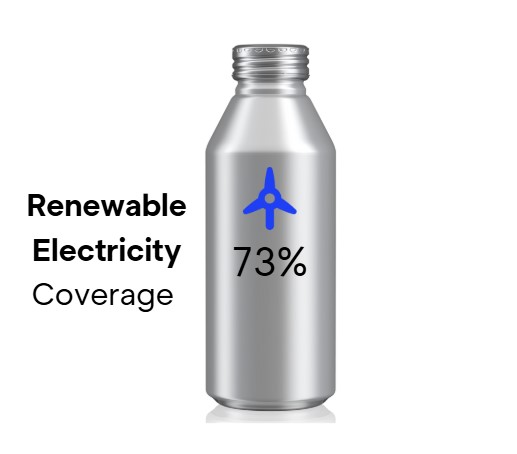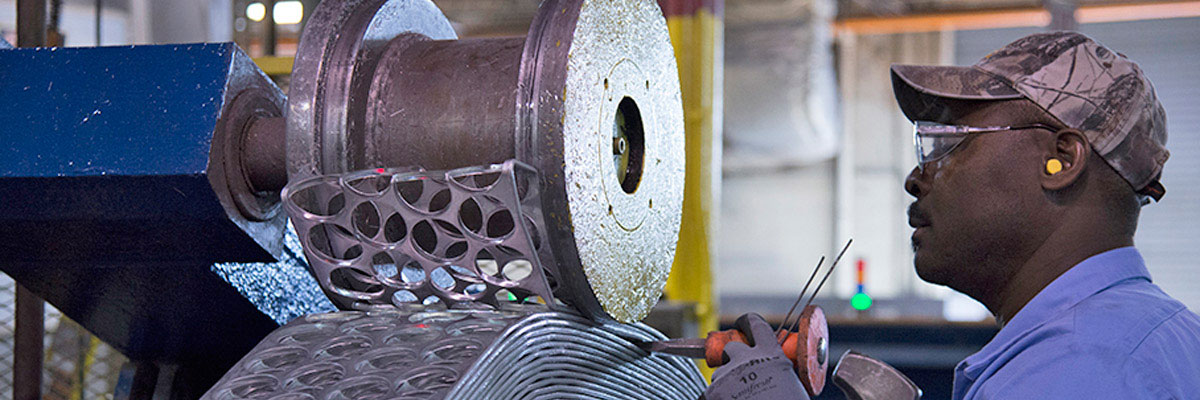
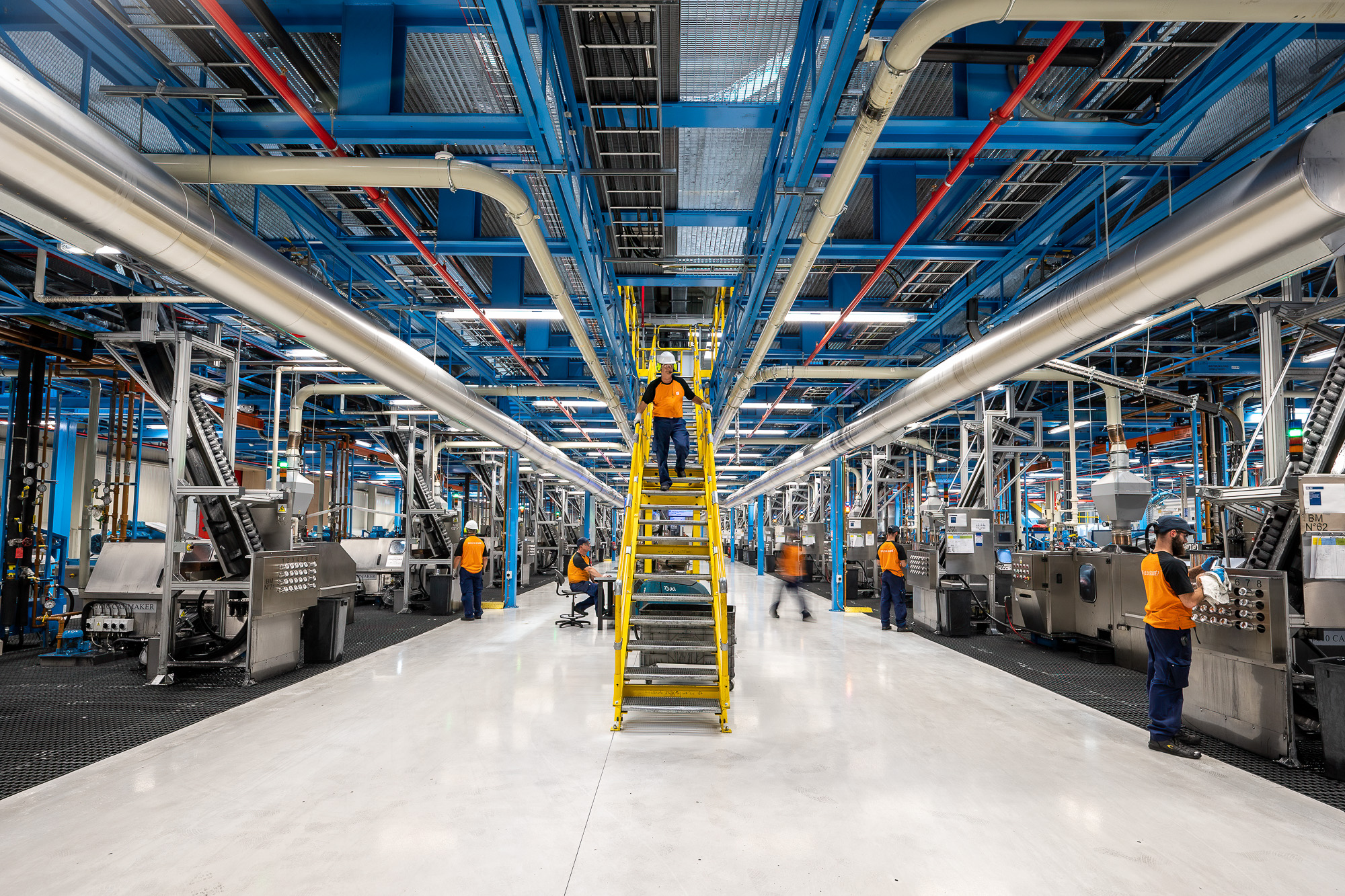
Resource Efficiency
Sustainability is embedded in our manufacturing operations and is a lever of operational excellence. We recognize the impact our operations have on the environment and the local communities where we operate and are committed to continuous efficiency improvements. We introduce innovative processes and technologies that improve our safety track record, reduce energy and water consumption, cut greenhouse gas emissions and divert more waste to beneficial use.
Employee engagement and commitment to sustainability are key to our operational success. To make sustainability more tangible for our employees, we introduced the “Big 6” concept in 2008 to focus the attention of Ball employees on the six most significant sustainability metrics in our operations.
Around the world, each Ball plant is accountable for these "Big 6" metrics and commits to annual goals as part of our strategic planning process. Each plant's performance is tracked monthly and reported to regional leadership teams. The businesses report their goal progress to corporate once each quarter and Ball's Sustainability Steering Committee reviews progress twice a year. To drive accountability and continuous improvement, goal achievement progress is also built into performance appraisals for plant management and operations leadership.
Lightweighting
In every step—from concept, design, manufacturing and filling to delivery of the final product to the consumer—innovation helps us identify and drive profitable growth. We work closely with our customers to understand their businesses and consumer demand, as well as the challenges and trends they encounter so we can develop industry-leading packaging solutions and graphics to help them grow their businesses.
Often invisible to the outside world, many of Ball’s successful product and process innovations—such as weight optimization of our cans or increasing manufacturing speeds—provide significant environmental and economic benefits to the company, our customers and consumers. We evaluate innovations through a variety of lenses, including consumer benefits, carbon footprints, costs and the impact of new products on the recycling process.
Our intent is to make the lightest metal containers possible while meeting the performance requirements of our customers. Even small weight optimizations save significant amounts of metal, costs, energy and emissions when multiplied by the billions of containers that Ball produces each year. That is why weight optimization represents a major contribution to our 2030 resource efficiency goals.
Ball’s ReAl® alloy can contains up to 100% recycled content and is 30% lighter than a standard aluminum aerosol can. Globally, 70% of Ball’s personal and home care production was made using our lightweight ReAl® alloy in 2024, up from 66% in 2023.
Visit our ReAl® page to learn more about this innovative technology.
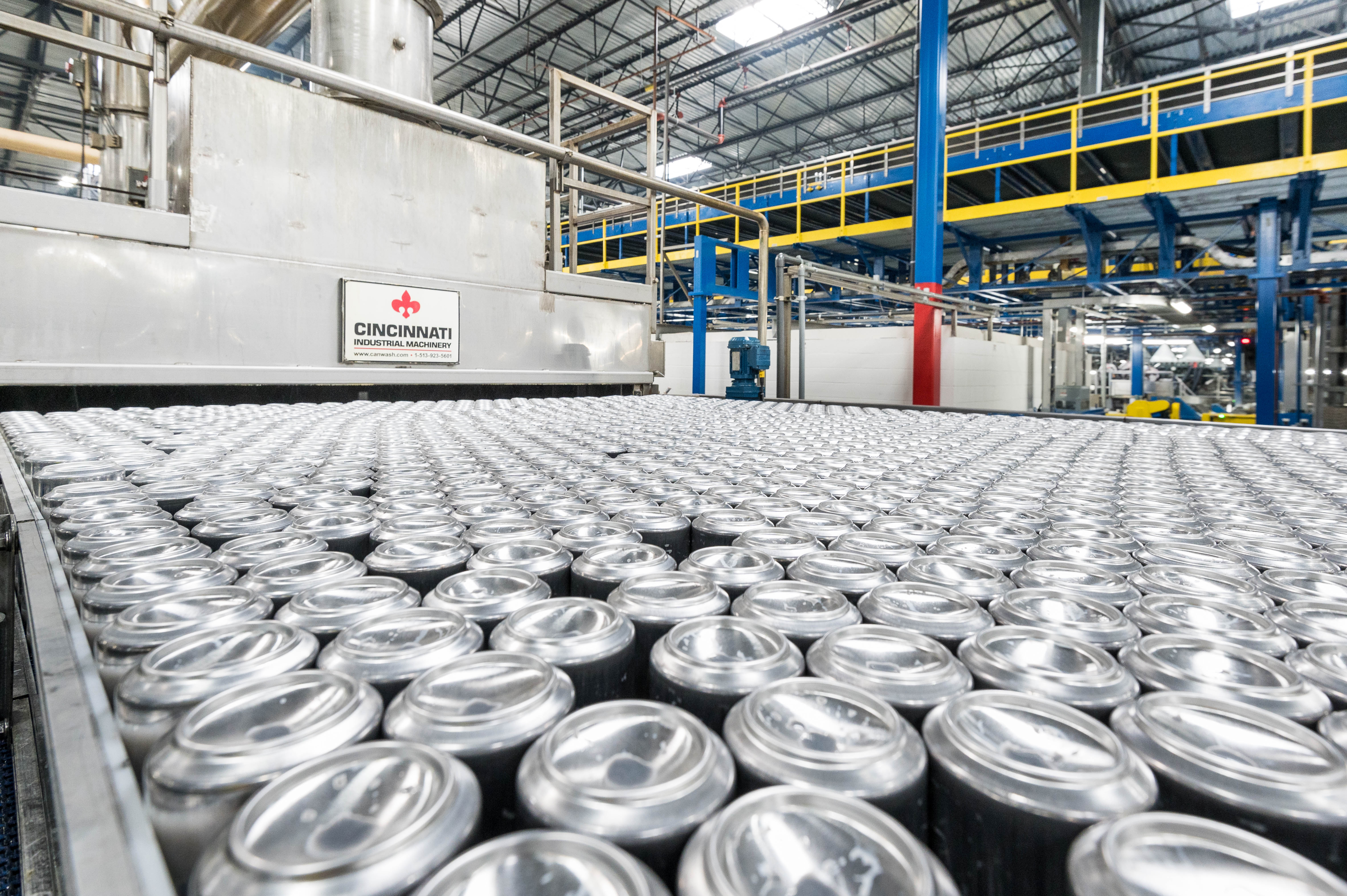
Water
Because access to fresh water is vital to consumers, our customers, our suppliers and Ball, we hold ourselves accountable for conserving and protecting water resources in our products, the communities where we operate and our entire value chain. A growing world population with greater demands for water-intensive food and energy, combined with increasing water needs and severe pollution of water resources in emerging economies, pose significant water supply constraints in some regions.
We continue to focus on reducing water usage across our plants; however, we focus our efforts on plants where water availability is an issue for local communities or where it creates operational challenges for us. As part of our 2030 water goal, in 2021 we began developing a roadmap for water management for our beverage packaging manufacturing plants, which includes guidance on water reduction, water recycling and local watershed engagement in areas of high water stress. In 2022, Ball partnered with the 100+ Accelerator to launch a pilot program with Waterplan, which has developed a platform to measure, address, and report water-related risks to ensure organizations progress toward water security. By leveraging external tools and internal subject matter experts, we are able to monitor water risks and manage plans to further minimize those risks. This better enables Ball to maintain business continuity at our manufacturing sites around the world.
Ball’s most water-intensive process is washing our cans during manufacturing. On average, washers account for about two-thirds of the total water consumption in a beverage can plant. To create efficiencies, Ball’s washer process occurs in counter-current cascades to reuse water at different washing stages.
To better understand, monitor and improve our water usage, Ball continues to invest in breakthrough technologies and innovative equipment that will allow us to change how much water we use in our operations. For example, many plants are replacing traditional deionizing water filtration with reverse osmosis systems. Water that has been treated through reverse osmosis can be recirculated and re-used more easily than water that has been deionized. We also invested in wastewater treatment technologies, evaluated advanced treatment options for effluents and installed several pilot systems to enable water reuse. Additionally, we are transitioning to new washer systems that will improve water efficiency.
In several plants, we also appointed and trained local water champions. These employees analyze water data, control water-consuming equipment and drive enhancements. While our goal is to reduce water consumption as much as possible, we also must diligently monitor the quality of produced cans. If we reduce the water intake of washers too much, the quality of our cans is affected and spoilage increases.
Because water is used in many steps along the packaging value chain—whether in mining and metal manufacturing or electricity generation—as well as in the production of the products that are put into our packaging, we maintain an open dialogue with our suppliers, customers and the communities where we operate.
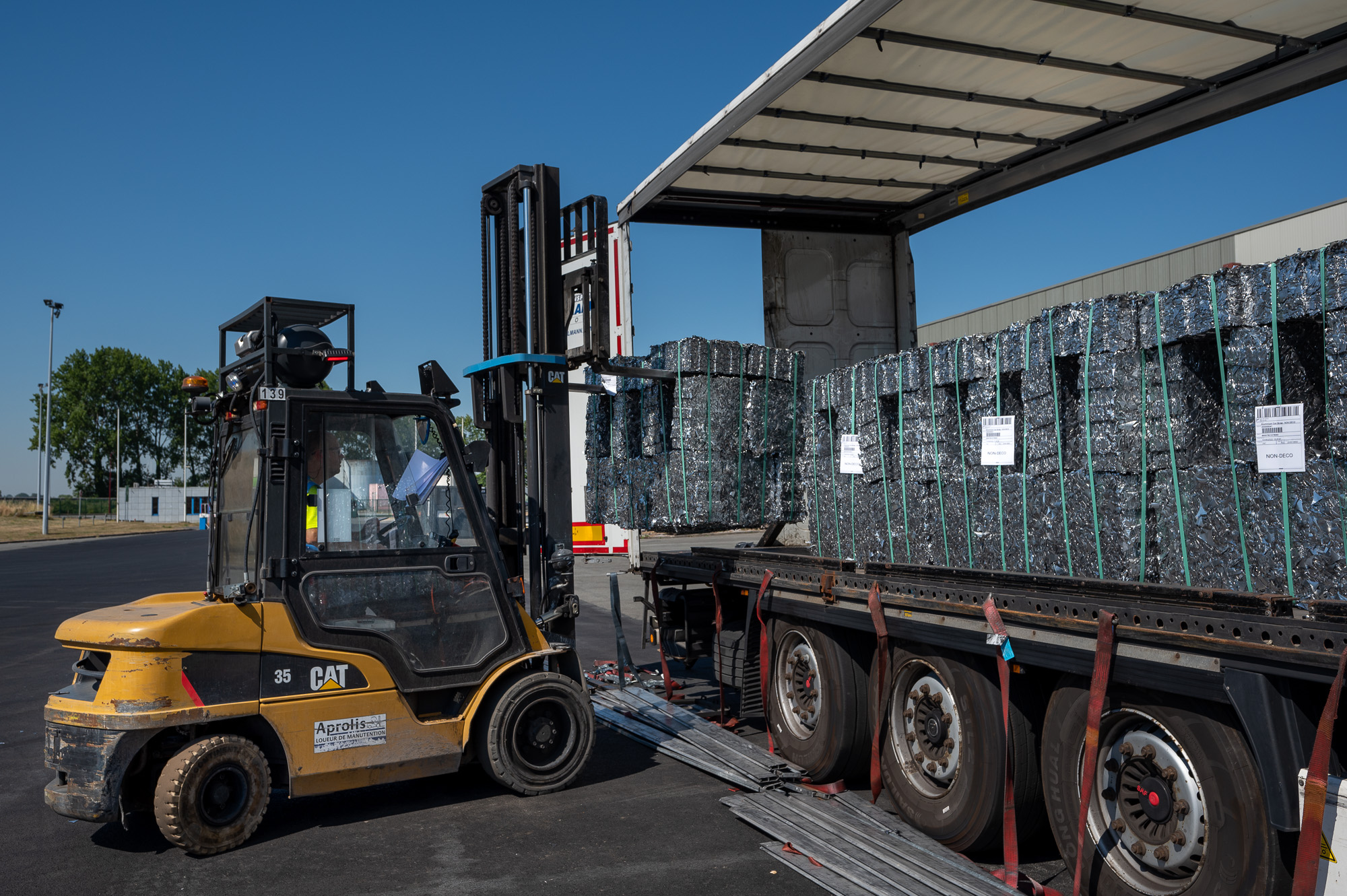
Waste
Material use and waste volumes are important yardsticks in evaluating the efficiency of our processes. Reducing spoilage in our manufacturing processes and recycling all metal production scrap are the most obvious ways that Ball can conserve resources and generate additional revenue. As our business continues to evolve and production volumes grow, our waste strategy remains the same—focus on systematically reducing the amount of waste generated, eliminating waste sent to landfills and increasing recycling rates.
To ensure our employees are equipped with the knowledge and skills to manage waste effectively, we conduct comprehensive waste management training programs in our NCA Beverage Packaging plants. These trainings cover best practices in waste reduction, recycling, and proper disposal methods. By empowering our team with this essential knowledge, we aim to minimize our environmental footprint and promote a culture of sustainability within our organization.
Another key component of our waste management strategy is the integration of recycling programs to reduce the waste sent to landfill. These programs are designed to maximize recycling efforts and ensure that recyclable materials are properly sorted and processed. Through these initiatives, we strive to continuously improve our waste management practices and contribute to a more sustainable future.
Approximately 11% of the total waste generated by Ball is either reused or recycled and 81% is considered scrap metal that is then recycled. Our waste management efforts focused on increasing our waste diversion efforts through reuse, recycling and other recovery options.
The monitoring provides insight on where the biggest opportunities exist to reduce waste and divert it from less beneficial streams like landfill and waste-to-energy. We continue to educate our employees about the benefits of recycling, provide a convenient recycling infrastructure in our facilities and cultivate a conservation mindset. Operations leaders and facility management support plant efforts and provide assistance. Since 2015, we have increased the amount of waste that is recycled and reused 55%.
Since 2008, we have diverted the filter cake in our operations from landfills. Filter cake accumulates during wastewater filtration and represents the largest waste stream by weight in our aluminum beverage can plants, accounting for up to 60% of a plant’s total waste. Ball has continued to identify opportunities to divert filter cakes from the waste stream. Some recent solutions include using filter cakes for alternative daily cover on landfills and as an ingredient in cement kiln processing.

Energy
As we are driving to reach 100% renewable energy around the world, we are also improving energy efficiency at all of our manufacturing plants.
We are committed to reducing the amount of energy required to produce each beverage can in our manufacturing plants by 30% during this decade. This primarily means cutting back on our use of electricity and natural gas. Since our Global Beverage Packaging business accounts for most of our energy consumption, much of our efforts are focused in this business. Given we have plans in place to eliminate all GHG emissions associated with electricity by 2030 through the use of 100% renewable electricity, our attention is now on reducing the use of natural gas.
To significantly and cost effectively reduce our energy consumption, we follow a global energy strategy that addresses energy supply and demand and requires the consideration of energy efficiency when making investment decisions.
To further accelerate our progress we continued to invest in energy monitoring across our global network of beverage can manufacturing plants. In order for Ball to harness the power of this data, we began implementing a software solution with Artificial Intelligence (AI) to make predictive, accurate, and actionable decisions to optimize our roadmap on reducing energy and water use, carbon emissions and utility costs. This system will not only provide our plant operators with real-time insights into improving energy efficiency on a day-to-day basis, but will allow our regional engineering and operations teams to optimize future investments while meeting our sustainability goals.
We have also began exploring the potential for electrification of ovens used in our can making process that traditionally use natural gas – including working with key suppliers to begin testing electric heating options at our innovation center in Colorado. Through electrification of thermal energy loads and the use of renewable electricity, there is great potential to reduce fossil fuel use and Scope 1 GHG emissions. However, this can increase our demand for electricity which further informs our projections for renewable energy needs.
We continued to install more efficient compressors and connected additional equipment to low-pressure systems during the reporting period. At the end of 2019, 59% of our beverage can plants operated dual-air systems that supply equipment with either high- or low-pressure air. Compared to traditional systems that rely only on high pressure, low pressure compressed air is 22% more energy efficient than high pressure air, and also results in less energy loss through artificial demand.
In 2024, 11 Ball plants across North and Central America (NCA) implemented a network-wide project to install variable frequency drives (VFDs), optimizing motor performance while aligning with industry best practices and Ball’s latest global standard. The VFDs reduce motor speeds on washer pumps, oven blowers, line-control and necker motors. Reducing speeds by 10% decreases power usage by 27% without impacting operations. Four NCA plants installed new valves on bodymakers to reduce point-of-use air intensity. The valves reduce the amount of time air has to be applied, reduce quality defects and lower the air pressure needed to complete the process. The project has reduced energy intensity by 3.7% at those facilities.
In Italy, Ball’s Nogara plant continues to set the pace for energy-saving innovations. In 2024 they adjusted vacuum-pump modulation, installed low-pressure compressors and improved line control and energy monitoring. Over the past five years, these initiatives contributed to a reduced electricity intensity by 22% at the Nogara plant.
In South America, Ball plants in Brasília, Extrema, Jacarei, Recife and Paraguay installed gas pressure stabilizing valves on our oven gas trains. The valves ensure stable and optimal pressure throughout the oven’s power range, reducing energy intensity by 3–5%.
BOE starts with our people — our operators, subject matter experts and leaders who understand what works best in our plants and supply chain. We build on proven local and regional practices to define global standards that improve safety and enhance performance. As we continue learning and innovating, we raise the global standard, accelerating improvements across Ball’s operations.
By empowering our teams to drive improvements, we enhance safety, quality and consistency while removing cost and waste from our operations. Investing in the teams who lead our production workforce, we offer Pathway, a technical standardized training that will significantly shorten the time required to develop world-class can makers.
Through BOE, we are simplifying work, strengthening execution and unlocking operational efficiencies that will deliver approximately $500 million in gross aluminum packaging cost savings between 2024 and 2027.
Biodiversity
Although Ball facilities are typically located in industrial zoning sites, as part of the ASI certification process, we have begun undergoing an internal biodiversity audit of several manufacturing facilities. Examples below describe efforts underway across our regions.



